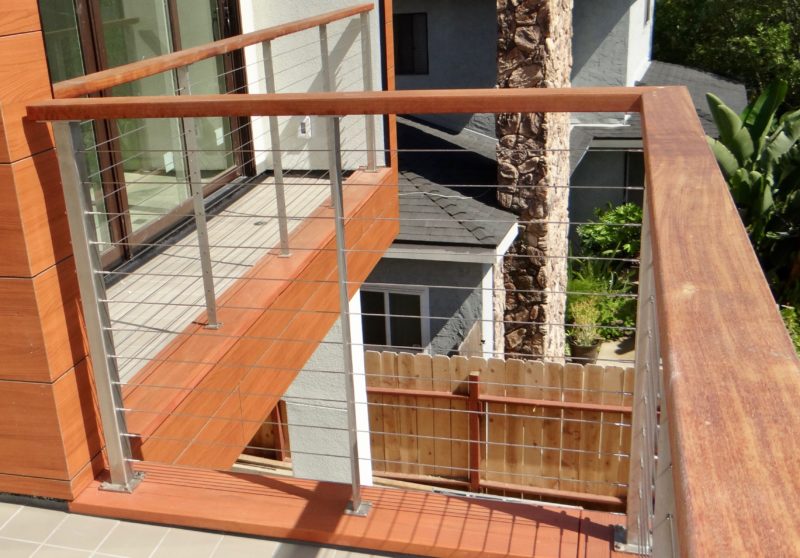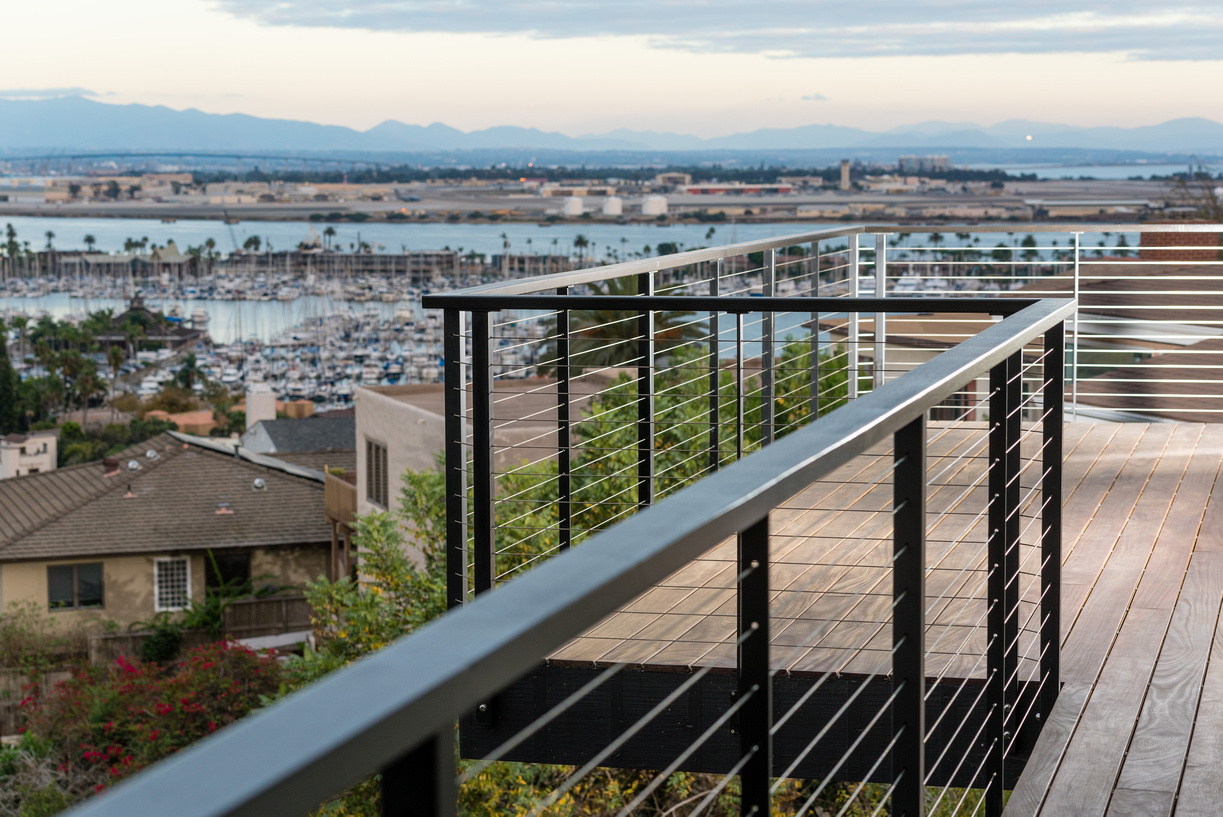




Building Safer Decks More than 50% of outdoor decks in America are in need of repair or deemed “unsafe.” Consumers and deck enthusiasts alike should consider professional deck inspections on a periodic basis to ensure the safety of outdoor structures. Issues like soft wood, dry rot, corrosion to structural fasteners and even normal wear and tear can compromise the integrity of your deck. Here are some ways you can improve the safety and security of your outdoor decks and railing systems: PERFORM AND ANNUAL DECK INSPECTION: An annual walk around inspection of your decking planks and understructure is simple to do by visually inspecting your deck. If the understructure is not accessible; removing planks in periodic locations to visually assess the frame is advised. Inspect high traffic or exposed areas like stairways and doorways; drip lines from overhanging eaves are high risk areas. Any locations on the deck where water pools, and places where staining has occurred are good locations to look first. If you have a raised deck with good access to the understructure; visually inspect connections and hardware for rust or fastener degradation. Increasing Corrosion Resistance and Deck Longevity Wooden decks will require more upkeep than composite decking systems and should be inspected more often with possible repairs in mind. Wooden railing systems like picket style railings with top and bottom rails should be inspected where wooden members intersect. If railing posts are wobbly or do not offer sufficient lateral resistance; consider replacing your deck railings. Older wooden railing frames can be replaced with new modern railing posts like steel powder coated frames that offer a much longer lifespan. As long as the deck structure is sound, a new railing system can be installed with ease and greately increase the safety and longevity of your deck. Cable railing kits, and glass railing systems offer extreme corrosion resistance when compared to traditional wooden picket railing systems. Maintenance is minimal in both cases; minor annual cleaning and inspection is required to keep these railings in tip top condition. PROFESSIONAL DECK INSPECTORS: A professional deck evaluations is always a good idea for older wooden decks. Depending on exposure and material types a deck can last from 10-30 years before major repair is necessary. Local deck and railing pro’s have worked on hundreds of decks both new and old and have the specialized experience to evaluate for structural issues that may arise. In some cases a “retrofit” to an existing structure is possible. Deck Retrofitting vs. Complete Replacement While a retrofit of an existing deck can increase deck safety; some decks will requrie a complete replacement. Our deck professionals at SDCR perform replacements with new and modern decking materials like Trex composite planks and high performance railing systems like stainless steel cable and glass panel railings. Pressure treated deck frames, raised concrete footings, and composite or hardwood planks will offer the most in deck safety and longevity. The up front cost of a deck replacement can be a substantial investment but the peace of mind and enjoyment customers get from a well designed outdoor space that lasts for decades is worth the costs involved. DIY Deck Repairs vs. Hiring a Deck Builder Simple repairs like a plank replacement or swapping out some deck screws can be pretty simple for DIY enthusiasts. Structural issues, railing construction, stairs, and full deck replacements can be more suited for hiring a pro. Our preferred contractors at San Diego Cable Railings have installed hundreds of decks, fences, and modern railing systems in the harshest conditions. Our railing kits offer a multitude of solutions for simple DIY railing repairs; from hand crimp cable hardware to swageless cable railing products. If you have questions about deck safety and repairs prior to installing new railings, feel free to give us a call or visit the QUOTE REQUEST form for a free estimate on our popular railing and glass railing systems. Our sales pro’s and preferred contractors build safer decks and railings for customers all over California. CLICK HERE TO REQUEST A QUOTE FROM OUR SALES TEAM! Deck Safety Deck Safety Checklist MavenNovember 25, 2024 Modern Deck Railings, Stainless Steel vs. Aluminum Modern Deck Railing Ideas MavenOctober 21, 2024 100% American made Steel, Stainless Steel vs. Aluminum Aluminum vs. Stainless Steel Railing Comparison MavenSeptember 30, 2024 Cable Railing News Stair Railing Ideas MavenSeptember 6, 2024 Safe Deck Railings Pony Wall Railing Renovations MavenAugust 20, 2024 Browse More Posts Add Your Heading Text Here

California is home to a TON of decks. A short drive up the coast and a scan of the bluffs make it easy to see that almost every home has a deck or patio of some sort. With good reason; decks expand outdoor living opportunities and enjoyment. They preserve amazing views while we dine outdoors. While these cantilevered hillside platforms are enjoyable, care must be taken to maintain and inspect them periodically. Knowing the age and condition of your deck is important for safe use and enjoyment for many years. Structural Considerations and Deck Safety Structural framing is the main thing to consider for residential deck inspections. Most deck builders recommend annual or bi-annual inspections for older decks (10 + years). Posts, beams and joists must be inspected for dry rot or termite damage. Decking should be examined for soft spots or bad connections. Footings can be inspected for settling or cracking. The North American Deck and Railing Association compiled this deck evaluation checklist. The checklist can be a helpful resource for pros and homeowners alike. It has been estimated that almost half of the decks in North America are past their useful lifespan. NADRA’s checklist covers many items including stairs, railings, and flashing to name a few. Lifespan of the Average Deck Any veteran carpenter will tell you that wood is not what it once was. Gone are the days of old growth timber with tight grain patterns. Todays lumber is taken from much younger trees with wider grain and a shorter lifespan. In addition, the moisture content is very high in much of the framing lumber and treated timber sold today. For these reasons, deck builders and homeowners alike should be diligent with deck maintenance and inspections. Wet lumber can result in more cracking due to drying out too fast, and nail pops due to shrinkage. Depending on the materials selected and UV/moisture exposure, an average wooden deck lasts 10-20 years. Composite decks, dry decks, and exotic hardwood decks can last up to 30 years and longer. The most common factors affecting the lifespan of your deck include the following: – Dry Rot -Moisture Intrusion -Termites and Other Pests Airflow is very important to the lifespan of your deck. Elevated decks that get plenty of ventilation can last a very long time. Performing regular maintenance will increase deck safety and longevity; get your deck inspected on a regular basis as it gets older. Choosing high quality materials like San Diego Cable Railings can also extend the life of your deck while adding safe barriers for all to enjoy. The Best Railings for Deck Safety Stainless steel cable railings are some of the strongest most durable railing systems available for your deck. The breaking strength of one strand of 1/8″ cable can exceed 1800 lbs. Combined with durable stainless steel posts and rails, or even a hardwood hybrid combo; cable railings can last 30-50 years. Cable railing systems are code compliant and aesthetically pleasing; a top choice for the ultimate in deck safety.

If you’re building a raised deck it’s important to understand the basic safety and loading requirements for standard construction. Thousands of people are injured annually due to deck and porch accidents. Structural instability is almost always the cause for these deck failures and for this reason we offer our customers the following info. Understanding live loads, lateral loads and post spacing requirements can be a great asset to any deck building project. Live loading requirements are commonly referenced when discussing the amount of weight a deck must be able to safely carry. A common requirement for today’s decks is 60 psf. The PSF abbreviation refers to “pounds per square foot.” Simple calculations can be performed in order to calculate the live load requirements for your deck, based on span tables like the one shown below: Code Requirements for Decking Loads A pounds per square foot calculation at 60 psf. will provide a safety factor for any raised platform that can safely accommodate the weight of persons and furniture on the deck surface. A well built deck should always lean towards “over built” for additional loading, snow loads etc. In many cases, a 2 to 1 safety factor is the safest approach. Simply stated a 60 pound per square foot floor load should already contain this safety factor. As these requirements can vary by area; it’s always best practice to check local codes. The code height requirement for deck railings in California is 42″ finished height from the top of the decking to the top of the railing. Any openings in the infill must prevent a 4″ sphere from passing through the railing. A 36″ railing height is required for stairs with graspable railings required in many cases. Customers purchasing pre made railing posts should consider that the finished post height allows for a solid connection that will withstand a 200 pound lateral load applied to posts or railing sections in any direction. Deck Safety Requirements for Railing Posts Post spacing will greatly influence the overall strength and loading ability of a deck railing. Call outs for railing post installations that exceed 6′ spacing will not likely pass a building inspection. For cable railing systems a max spacing of 4′ on center will commonly be required to ensure that 3″ cable spacing can carry sufficient tension to pass a 4″ sphere test. For glass railings a max post spacing of 5′ is often recommended. Many online retailers call for up to 8′ spacing for deck railings however our preferred contractors do not recommend this for any raised deck surface. Choosing the Sturdiest Decking and Railing Products Customers looking for high strength and durability will find that only top quality materials can provide the best finished product for passing inspections. Hardwood decking planks like Ipe’ and Cumaru offer the same span capabilities at 1″ thickness that other wood types call for 1.5″ thickness. Durability of hardwood products is also likely at least double that of popular soft wood choices. In some cases hardwood is 30 times more dense than standard framing lumber. Composite decking planks like Trex are a low maintenance option for exterior decks; with some warranties lasting 25 years. Customers selecting composite products should however consider the fact that these products are not structural in nature; and that framing requirements may need to be more stringent for composite decking. Joist spans may need to be tightened in order to maintain stability. When selecting a railing for ultimate strength; steel posts and rails will almost always offer more strength than wood by comparison. Only hardwood species can come close to steel in terms of strength and hardness. In addition, the longevity and wear resistance provided by steel and stainless steel railings is also much higher than wood. San Diego Cable Railings is dedicated to the production of high quality stainless steel railing systems. Our company sells a full line of cable and glass railings, as well as engineered railing posts for a variety of applications. If you have questions about deck safety requirements on your project; or you would like an estimate for deck railings click the link below.